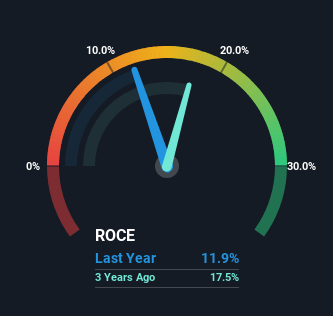- China
- /
- Semiconductors
- /
- SHSE:688503
Changzhou Fusion New Material (SHSE:688503) May Have Issues Allocating Its Capital
If you're looking for a multi-bagger, there's a few things to keep an eye out for. One common approach is to try and find a company with returns on capital employed (ROCE) that are increasing, in conjunction with a growing amount of capital employed. Put simply, these types of businesses are compounding machines, meaning they are continually reinvesting their earnings at ever-higher rates of return. Although, when we looked at Changzhou Fusion New Material (SHSE:688503), it didn't seem to tick all of these boxes.
What Is Return On Capital Employed (ROCE)?
Just to clarify if you're unsure, ROCE is a metric for evaluating how much pre-tax income (in percentage terms) a company earns on the capital invested in its business. The formula for this calculation on Changzhou Fusion New Material is:
Return on Capital Employed = Earnings Before Interest and Tax (EBIT) ÷ (Total Assets - Current Liabilities)
0.12 = CN¥562m ÷ (CN¥7.7b - CN¥3.0b) (Based on the trailing twelve months to March 2024).
Thus, Changzhou Fusion New Material has an ROCE of 12%. In absolute terms, that's a satisfactory return, but compared to the Semiconductor industry average of 4.1% it's much better.
View our latest analysis for Changzhou Fusion New Material

Above you can see how the current ROCE for Changzhou Fusion New Material compares to its prior returns on capital, but there's only so much you can tell from the past. If you're interested, you can view the analysts predictions in our free analyst report for Changzhou Fusion New Material .
So How Is Changzhou Fusion New Material's ROCE Trending?
On the surface, the trend of ROCE at Changzhou Fusion New Material doesn't inspire confidence. Around five years ago the returns on capital were 21%, but since then they've fallen to 12%. However, given capital employed and revenue have both increased it appears that the business is currently pursuing growth, at the consequence of short term returns. If these investments prove successful, this can bode very well for long term stock performance.
On a related note, Changzhou Fusion New Material has decreased its current liabilities to 39% of total assets. So we could link some of this to the decrease in ROCE. Effectively this means their suppliers or short-term creditors are funding less of the business, which reduces some elements of risk. Some would claim this reduces the business' efficiency at generating ROCE since it is now funding more of the operations with its own money.
What We Can Learn From Changzhou Fusion New Material's ROCE
While returns have fallen for Changzhou Fusion New Material in recent times, we're encouraged to see that sales are growing and that the business is reinvesting in its operations. However, despite the promising trends, the stock has fallen 30% over the last year, so there might be an opportunity here for astute investors. So we think it'd be worthwhile to look further into this stock given the trends look encouraging.
One final note, you should learn about the 3 warning signs we've spotted with Changzhou Fusion New Material (including 1 which is potentially serious) .
For those who like to invest in solid companies, check out this free list of companies with solid balance sheets and high returns on equity.
New: AI Stock Screener & Alerts
Our new AI Stock Screener scans the market every day to uncover opportunities.
• Dividend Powerhouses (3%+ Yield)
• Undervalued Small Caps with Insider Buying
• High growth Tech and AI Companies
Or build your own from over 50 metrics.
Have feedback on this article? Concerned about the content? Get in touch with us directly. Alternatively, email editorial-team (at) simplywallst.com.
This article by Simply Wall St is general in nature. We provide commentary based on historical data and analyst forecasts only using an unbiased methodology and our articles are not intended to be financial advice. It does not constitute a recommendation to buy or sell any stock, and does not take account of your objectives, or your financial situation. We aim to bring you long-term focused analysis driven by fundamental data. Note that our analysis may not factor in the latest price-sensitive company announcements or qualitative material. Simply Wall St has no position in any stocks mentioned.
About SHSE:688503
Changzhou Fusion New Material
Engages in the research and development, production, and sale of conductive silver paste, electronic component paste, conductive adhesive, and semiconductor materials for photovoltaic industry in China and internationally.
Reasonable growth potential with adequate balance sheet.
Market Insights
Community Narratives



